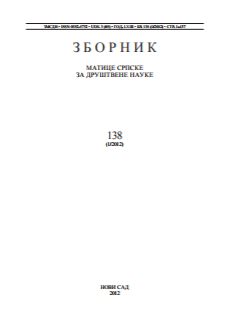СРПСКО СРЕДЊОВЕКОВНО ПРАВО: ОД ОСВЕТЕ ДО РЕЗЕРВАТА СУДСКИХ
SERBIAN MEDIEVAL LAW: FROM REVENGE TO RULER’S PREROGATIVE
Author(s): Đorđe ĐekićSubject(s): Law, Constitution, Jurisprudence, History of Law, Middle Ages, 6th to 12th Centuries
Published by: Матица српска
Keywords: revenge; pacification of blood; system of composition payments; blood brothers; godfatherhood; the ruler’s prerogative; Serbia; Bosnia;
Summary/Abstract: Since legal norms have come a long way from revenge to the ruler’s prerogative in the period between the Slavic arrival to the Balkans and the 12th century, this paper is an attempt to offer solutions for the chronology of these events. As the ruler’s prerogative occurs for the first time at the end of the 12th century, it is clear that this process had to have been completed by then. In the pre-state period Serbs had revenge and pacification of blood (godfatherhood), which were retained even after the state was established. In the state period the phenomenon of blood brothers occured as another form of pacification of blood. The existence of the system of composition payments can be proven indirectly. At the end of the 12th century the Old Serbian Law was created, which proscribed that the ruler tried for murder and theft of church property. This is the evidence that revenge disappeared in the meantime. Revenge and the system of composition payments remained legally valid ways of settling disputes in Bosnia until the end of the 15th century. As Bosnia was part of Serbia until the end of the 10th century, this implies that until that time revenge was a legally valid way of settling disputes in Serbia. This would mean that the abolishment of revenge and the transfer of this dispute to the competence of the ruler, when a blood debt was settled, which had been a remnant of the system of composition payments, occurred in the period between the end of the 10th century and the end of the 12th century, when it became part of the written law. As for the theft of church property, it must be said that the decisions of the Split (Spalatum) Assembly of 925 AD lead to the conclusion that the state accepted to regulate the theft of church property, which indicates that the mention of the theft of church property could have been the record of the ruler’s prerogative. Finally, it was noticed that at least one more felony – treason – had to be the regulated by the ruler’s prerogative. It was a felony that could be committed only against the ruler and the throne, for which the ruler himself tried the guilty party. Examples have proven that this is the oldest ruler’s prerogative and a presupposition was made that other forms of court orders were introduced after this model.
Journal: Зборник Матице српске за друштвене науке
- Issue Year: 2012
- Issue No: 138
- Page Range: 39-46
- Page Count: 8
- Language: Serbian

